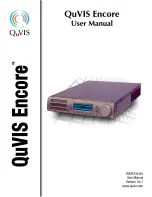
October 2001
Page 45
P/N 96-000001-017, Version Q301
Compatibility:
1) the ability of one computer to accept
and process data in the same manner as another
computer without modifying the data or the media upon
which it is being transferred. 2) the ability of one device
to connect or communicate with another system or
component.
Components:
elements or parts (of a system) which
make up the whole (system).
Computer Program:
a set of instructions written for a
computer that enables it to achieve a desired result.
Computer System:
a combination of hardware,
software, firmware, and peripheral components
assembled to process data into useful information.
Configuration:
the specific combination of hardware
components of the computer, and their operating
status. The configuration of your computer includes pre-
defined memory, type and speed of microprocessor,
type of and size of hard disk drive, etc.
Controller:
built-in hardware and software that controls
the functions of a specific internal or peripheral device
(e.g. digitizer controller)
Co-processor:
a circuit built into the processor that is
dedicated to intensive math calculations.
Cursor:
a small, blinking rectangle or line that indicates
the current position on the display screen.
D
Data:
the information the system stores and processes.
Default:
the parameter value automatically selected by
the system when you or the program do not provide
instructions. Also called a preset value.
Delete:
to remove data from a disk or other data
storage device. Synonymous with erase.
Device Driver:
a program that controls communication
between a specific peripheral device and the computer.
Diskette:
a flat magnetic-coated material used to store
programs and data. Unlike a hard disk drive, which is
rigid, a diskette is flexible and therefore often referred to
as a “floppy” disk.
Disk Drive:
the physical device that allows the system
to read from, and write to, a disk. A floppy disk drive
allows you to insert and remove diskettes, while a hard
disk drive is permanently sealed inside a disk drive.
Display:
a CRT, plasma screen, LCD, or other image
producing device used to view computer output.
Documentation:
the set of manual and/or other
instructions written for the users of a computer system
or application. Computer system documentation
typically includes procedural and tutorial information as
well as system functions.
Double -tap:
to press and release the pen/stylus twice
within a time frame defined by the user, without moving
the pointer off the choice.
Driver:
software that allows an application program to
communicate with a particular piece of equipment, such as a
printer or the pen/stylus.
E
Expanded Memory:
special additional memory designed to
extend the 640KB limit imposed by DOS, and recognized by
many, but not all, DOS application programs.
Extended Memory:
memory beyond the first 1 MB of memory
recognized by DOS.
F
File:
a collection of related information; a file can contain data,
programs, or both.
Firmware:
a set of instructions built into the hardware which
controls and directs the microprocessor’s activities.
Floppy Disk:
see diskette.
Floppy Disk Drive(FDD):
an electromechanical device that
reads and writes to floppy disks.
Format:
the process of readying a blank disk for its first use.
Formatting establishes the structure of the disk that the
operating system expects before it writes files or programs onto
the disk.
Folder:
an icon Windows uses to store documents or other
folders.
H
Hard Disk Drive (HDD):
a sealed mass storage device used for
storage and fast retrieval of programs and data. The factory
installs this disk and only a trained engineer can remove it for
servicing.
Hardware:
the physical electronic and mechanical components
of a computer system: typically, the computer itself, CPU,
memory, etc.
Hertz:
a unit of wave frequency that equals one cycle per
second.
Host Computer:
the computer that controls, regulates, and
transmits information to a device or another computer.
I
Icon:
a small graphic image displayed on the screen or in the
indicator panel. In Windows, an icon represents an object that
the user can manipulate.
Instruction:
statements or commands that specify how to
perform a particular task.
Interface:
1) hardware and/or software components of a
system used specifically to connect one system or device to
another. 2) to physically connect one system or device to
another to exchange information. 3) the point of contact
between user, the computer, and the program (e.g. the
pen/stylus or a menu).
Summary of Contents for GeneSys
Page 1: ...User Guide GeneSys Pen Tablet Computer ...
Page 30: ...October 2001 Page 30 P N 96 000001 017 Version Q301 ...
Page 31: ...October 2001 Page 31 P N 96 000001 017 Version Q301 Memory Menu DisksMenu ...
Page 32: ...October 2001 Page 32 P N 96 000001 017 Version Q301 ComponentsMenu ...
Page 33: ...October 2001 Page 33 P N 96 000001 017 Version Q301 ...
Page 34: ...October 2001 Page 34 P N 96 000001 017 Version Q301 ...
Page 35: ...October 2001 Page 35 P N 96 000001 017 Version Q301 PowerMenu ...
Page 36: ...October 2001 Page 36 P N 96 000001 017 Version Q301 ...
Page 37: ...October 2001 Page 37 P N 96 000001 017 Version Q301 Exit Menu ...
Page 38: ...October 2001 Page 38 P N 96 000001 017 Version Q301 ...
Page 39: ...October 2001 Page 39 P N 96 000001 017 Version Q301 ...
Page 40: ...October 2001 Page 40 P N 96 000001 017 Version Q301 ...
Page 48: ...October 2001 Page 48 P N 96 000001 017 Version Q301 ...




































